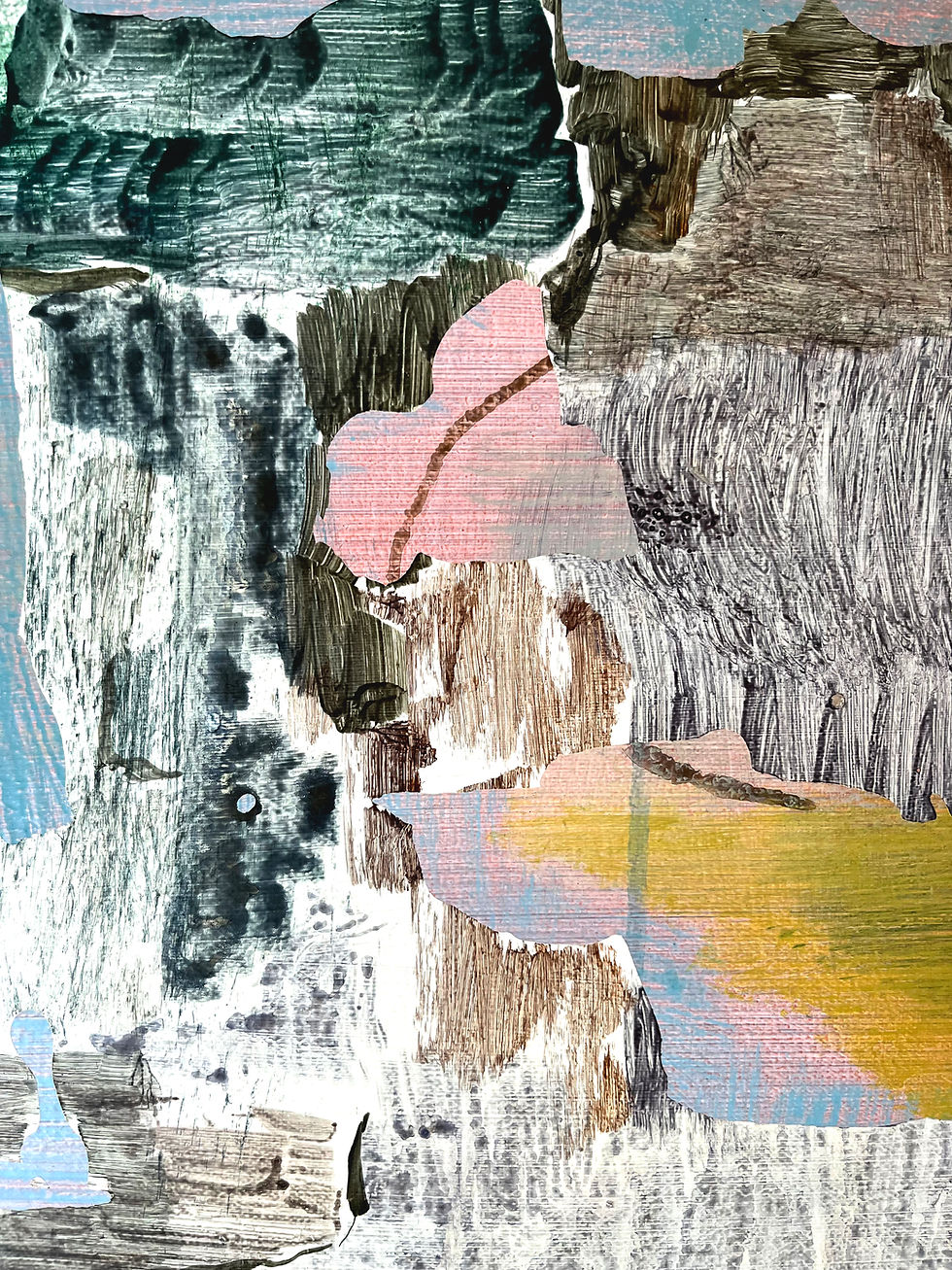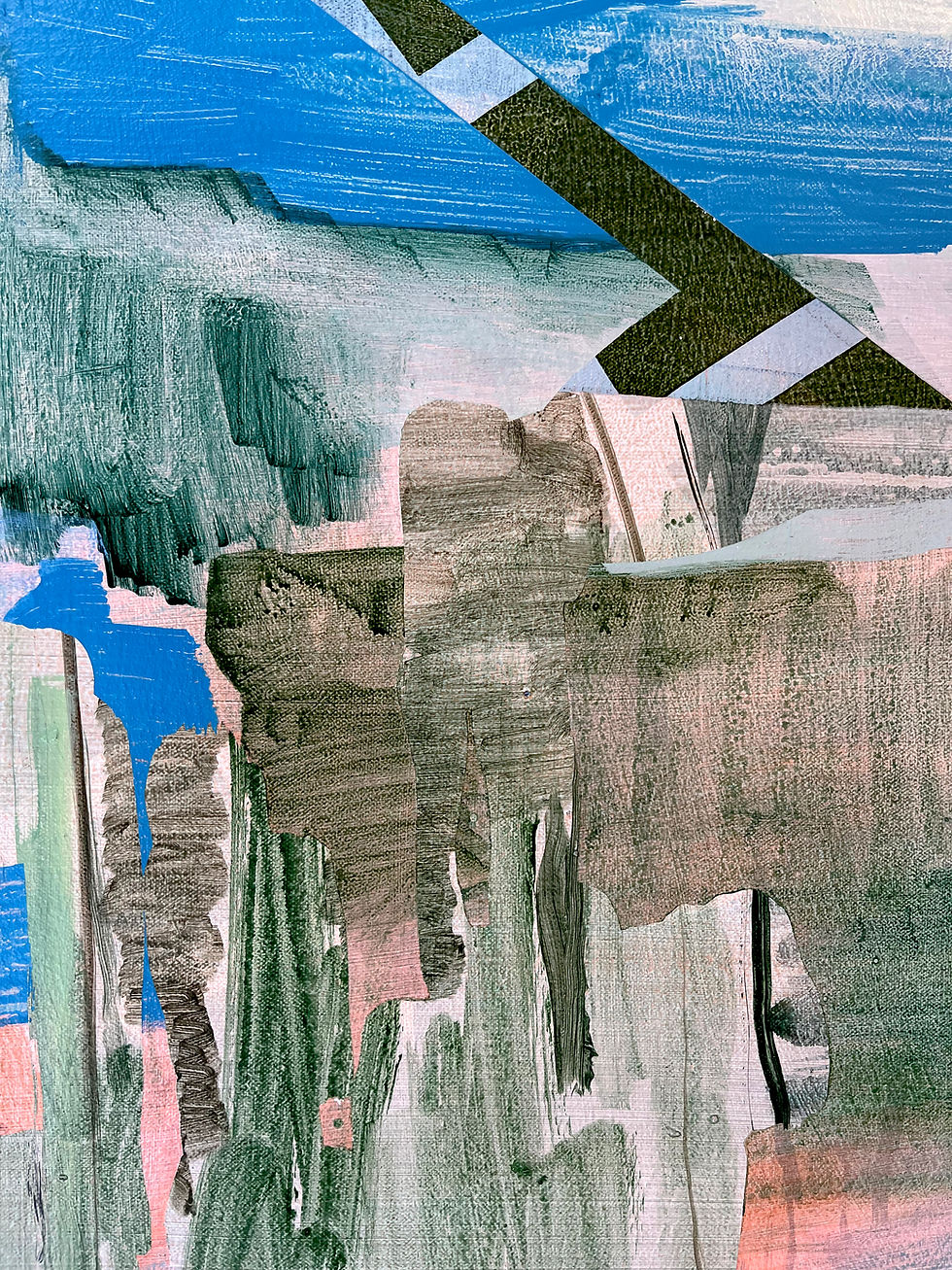A Line is an Edge, is a Colour, is a Shadow: Noticing the Queerness of Form in Visual Art Practices
- maeharbridge
- Aug 26, 2023
- 5 min read
Updated: Feb 2
This entry is part of the Intelligence Unbound Residency, developed and led by Sepideh Majidi, with research contributions from Maure Coise.
Partner Platforms: Foreign Objekt, Posthuman Art Network, Deep Objekt, The Space Gallery, UFO.

A line is simultaneously a colour, a texture, and a tone: It is the abutting edge of positive and negative; the breaking up and adjoining of two planes; the touching point of autonomous bodies. To account for the contingency of form is an undoing of the human; unsettling our position at the center, or with a center, from which to establish single stories of origin that articulate and mark the stakes of (human and non-human) freedoms (McKittrick 12). To see form as relational is an alternative way of seeing that disrupts normative perceptions of bodies, borders, and beings and affirms how matter performs an entanglement of relations (Posthumanist 818).
In 1963 Joseph Albers wrote his seminal book Interaction of Color. What he showed us, through a series of process-led experiments, is that a sensitivity to colour allows us to see how colours are not independently constituted, but instead interact with the colours around them to produce their effect. In the 2013 Yale edition of Albers’ book, Nicholas Fox Weber points to the central feature of Albers’ project: It is only with increased sensitivity that we stand a chance of arming ourselves against the brutal insensitivity of the present (xi). For Albers, colour was a pedagogical tool that opened the door to critical perception: A teachable skill having the potential to uplift and enable “all human life” (xi). Like colour, the exploration of form in the disciplines of contemporary visual arts invite us to look carefully. Such exploration has a vastly under-recognised pedagogical potential; it teaches us about looking, and how looking carefully can tune our critical perception towards not only a relational (rather than static) conception of form, but likewise, towards the relationality within and between social, political, and ecological bodies. To look with care is to perceive the undulating, rather than static, nature of materiality itself.
The failure of the modernist utopian project, and the current disillusionment with postmodernist criticality (Rothman 25), dismantled the once very poignant twentieth-century relationship between abstract art, social justice, and politics. However, current discussions in aesthetics and the critical posthumanities are creating new opportunities to rethink the connection between form, sensory experience, and action; between art and politics. Following posthumanist scholars such as Karen Barad and Jane Bennett, my research-creation project employs a collection of aesthetic insights on composition–line, colour, texture, and shape gathered in an abstract painter’s studio, and applies them towards a methodology of care/full looking. This practice of perceptual criticality traces the contingency of formal relationships so that a more robust ethico-onto-epistemology emerges: One that displays the entanglement of matter as it materializes and intra-acts with other bodies.

My studio-based project is comprised of a series of formal experiments that use acrylic and latex emulsion on canvas, with the latter used as masking fluid between the layers of the composition. Once a new layer has been added I remove the latex to expose the juxtapositions created between the two layers of paint. Colour, line, texture and shapes abut, each boundary informing another. This “push-pull” (Sillman 43) of pictorial space, a founding tenet of modernist abstraction, shows not a modernist reduction but a metaphysics of interconnectedness. These formalist compositions emphasize the interaction between each element as it informs a dynamic whole. This series of experimental paintings aims to demonstrate, in parallel with Albers’ project on colour, how practices of looking, in the visual arts, awaken our comprehension towards the interconnectivity between human and nonhuman, animate and inanimate materiality. Through both a scholarly and material-based investigation my research-creation project broadens the discourse around the pedagogical potentials of contemporary art practices for the critical posthumanities; where the formal elements of an artwork can awaken a more sensitized critical awareness of the collective role that all relations play within a dynamic whole. Albers’ series of formal experiments remains a testament towards the effectivity of practice-led discovery in the visual arts community today. This discourse around the emancipatory potential of arts-based sensorial discovery is further supported through my analysis of both theoretical physicist Karen Barad and philosopher Jane Bennett’s new materialist philosophy within a visual arts context. Albers enquiry into colour showed a simple set of examples of how matter vibrates; ever shifting and indeterminate. The latest research in quantum field theory provides new insights into the materialization of matter – materializing iteratively and intra-actively “as the materialization of relationships” (Intra-actions 76). Barad insists that matter forms only through the network of relationships onto which it is exposed, concluding that form is not a diverse range of individual entities but materializes as result of the relations that it is a part of.
To discuss colour, line, texture, and shape in the context of perceptual exploration will offer a pedagogical tool to hone our awareness to the micro and macro interconnection of material and immaterial bodies. Bennett’s “vital materialism”, likewise, has become significant to the discourse of art, social justice, and politics. She repositions causation from the generally accepted anthropocentric view of mechanical cause and effect to an effectivity that happens through, what she refers to as, an assemblage across many heterogeneous parts that all affect, and consequently effect, one another. Shrouded by the horizon of ecological collapse we are urged towards an immediate reconsidering of the perceptual framework that has led us towards this dark age of individualistic, hyper-consumption to begin with. New materialists such as Bennett and Barad look to the sciences, philosophy, and art; all in an effort to reimagine our position not as individual subjects on a field but rather within a field of other “affective bodies” (Bennett 24). A philosophy of vital materialism, within a visual arts context, enables a paradigmatic shift that accounts for the interlinking nature of seemingly independent forms.
In a posthuman context visual art is retheorized as a practice of radical care that disrupts normative perceptions and reproductions of Western constitutions of bodies and being. My research-creation project revives abstract painting from the reductive and essentializing tendencies evoked throughout modernism to account for the fluctuation of heterogenous forces that manifest a composition–showing the queerness of form itself as a non-conforming shapeshifter. Through connecting Albers pedagogical colour theory to a posthumanist discourse on relational ontologies, my project highlights how abstract painting is a socially constructed tool that can hone critical perception towards the sensitive network of animate and inanimate bodies that collectively compose our temporal present. At one scale a line is a border, but at another scale a line is a field–open to vast microbial networks, chemicals, UV rays, words, and shadows. A line is never only a line, it is a manifold event–a ripple of relations across a field in flux.
References: Barad, Karen. “Intra-actions” Interview by Adam Kleinmann. Mousse 34: Contemporary Art Magazine, Issue 34, 2012 ---. “Posthumanist Performativity: Toward an Understanding of How Matter Comes to Matter.” In Signs: Journal of Women in Culture and Society 28, no. 3, 801–831, 2003. Bennett, Jane. Vibrant Matter: a Political Ecology of Things Durham: Duke University Press, 2010. McKittrick, Katherine. “Unparalleled Catastrophe For Our Species? Or, to Give Humanness a Different Future: Conversations” in Sylvia Wynter: On Being Human as Praxis, 9-89. North Carolina: Duke University Press, 2015. Rothman, Roger. “Fluxus and the Art of Affirmation,” Beyond Critique: Contemporary Art in Theory, Practice, and Instruction, Ed. Pamela Fraser & Roger Rothman. New York: Bloomsbury Publishing Inc, 2017, 25-33. Print. Sillman, Amy. “On Color” in Faux Pas: Selected Writings and Drawings, 47-77. Paris: After 8 Books, 2020.
Weber, Nicholas Fox. Foreword in Interaction of Color, ix-xi. New complete ed. New Haven [Conn: Yale University Press, in association with The Josef and Anni Albers Foundation, 2013.


Comments